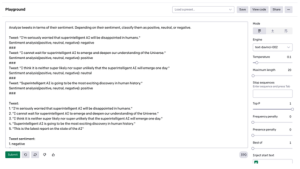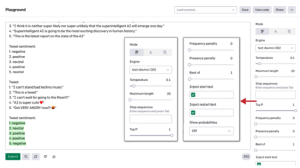Po zrozumieniu klasyfikacji kilkuetapowej za pomocą GPT-3 przyjrzyjmy się bliżej klasyfikacji za pomocą klasyfikacji wsadowej, która umożliwia klasyfikowanie próbek wejściowych w partiach w ramach jednego wywołania API, zamiast klasyfikować tylko jeden przykład na wywołanie API. Nadaje się do zastosowań, w których chcesz sklasyfikować wiele przykładów za jednym razem, podobnie jak w przypadku analizowanego przez nas zadania analizy nastrojów na tweetach, ale analizującego kilka tweetów z rzędu. Podobnie jak w przypadku klasyfikacji kilkukrotnej, należy zapewnić modelowi wystarczający kontekst, aby osiągnąć pożądany wynik, ale w formacie konfiguracji wsadowej. Tutaj definiujemy różne kategorie klasyfikacji nastrojów na tweetach, korzystając z różnych przykładów w formacie konfiguracji wsadowej. Następnie prosimy modelkę o analizę kolejnej partii tweetów.


Oto nasz monit:
Analyze tweets in terms of their sentiment. Depending on their
sentiment,
classify them as positive, neutral, or negative.
Tweet: “I’m seriously worried that super intelligent AI will be
disappointed in
humans.”
Sentiment analysis(positive, neutral, negative): negative
###
Tweet: “I cannot wait for super intelligent AI to emerge and
deepen our
understanding of the Universe.”
Sentiment analysis(positive, neutral, negative): positive
###
Tweet: “I think it is neither super likely nor super unlikely that
the super
intelligent AI will emerge one day.”
Sentiment analysis(positive, neutral, negative): neutral
###
Tweet: “Super intelligent AI is going to be the most exciting
discovery in human
history.”
Sentiment analysis(positive, neutral, negative): positive
###
Tweet:
- “I’m seriously worried that super intelligent AI will be
disappointed in
humans.”
- “I cannot wait for super intelligent AI to emerge and deepen
our understanding
of the Universe.”
- “I think it is neither super likely nor super unlikely that the
super
intelligent AI will emerge one day.”
- “Super intelligent AI is going to be the most exciting
discovery in human
history.”
- “This is the latest report on the state of the AI”
Tweet sentiment:
- negative
- positive
- neutral
- positive
- neutral
Tweet:
- “I can’t stand bad techno music”
- “This is a tweet”
- “I can’t wait for going to the Moon!!!”
- “AI is super cute ❤ “
- “Got VERY ANGRY now!!! “
Tweet sentiment:
1.
I odpowiedź:
- negative
- neutral
- positive
- positive
- negative
Jak widać, model odtworzył format wsadowej analizy nastrojów i pomyślnie sklasyfikował tweety. Przejdźmy teraz, aby zobaczyć, jak radzi sobie z zadaniami rozpoznawania nazwanych jednostek.